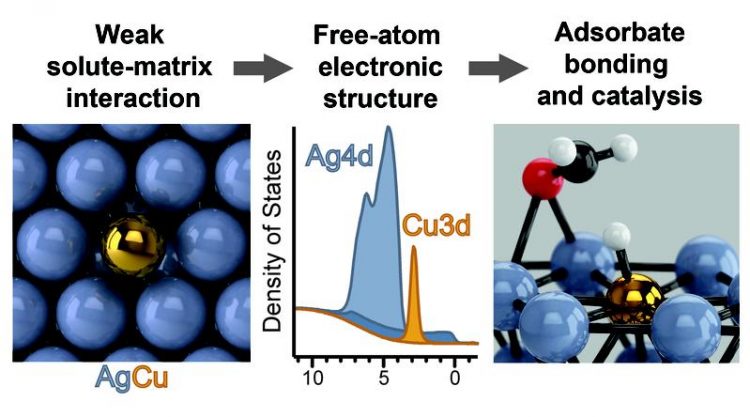Towards a new design paradigm for high-performance catalysts

Illustration of an isolated-atom alloy Nature Chemistry
The chemical industry relies on high-performance catalysts to produce the chemicals used by society – such as fuels, plastics and medicines. Some chemicals cannot be efficiently produced because the needed catalysts have not yet been discovered. A great deal of contemporary research is aimed at designing novel catalysts to fulfill these roles.
Recently reported in the journal Nature Chemistry, Greiner, Jones and Co. discovered a phenomenon that occurs in metal alloys that could yield a new design paradigm for high-performance catalysts.
The team of researchers found that when adding a very small amount of one metal to another, the minority element’s properties can change drastically, altering how it interacts with molecules. This finding is of particular interest to chemical industry, where the efficiency of chemical production often depends on how molecules interact with metal catalysts.
The team found that a dilute mixture of copper in silver results in certain properties that resemble free isolated atoms. Nature uses isolated metal atoms in biological catalysts called enzymes. These finely tuned catalysts are known for their unparalleled catalytic efficiency.
However, industrial catalysts have yet to capitalize on this phenomenon because they require much harsher conditions than biological systems can tolerate. Industrial catalysis must instead rely on less efficient inorganic materials in the form of macroscopic particles. By taking advantage of the properties of isolated atoms, there is the potential that catalytic efficiencies of industrial catalysts could rival biological systems.
Jones and Greiner made use of the recently developed concept of “single-atom alloys–alloys” in which the minority element forms no bonds to other minority element atoms. Using such materials, they showed experimentally that certain single-atom alloys exhibit properties that resemble isolated ions.
With theoretical calculations, they showed that a number of metal combinations should also give rise to this behavior, representing a class of hitherto unexplored class of materials whose catalytic properties can be tuned. These findings could open up a new paradigm for designing novel high-performance catalysts.
Dr. Mark Greiner
Max Planck Institute for Chemical Energy Conversion
Phone: +49 (0)-208-306-3686
E-mail: Mark.Greiner@cec.mpg.de
Dr. Travis Jones
Fritz-Haber Institute of the Max-Planck Society
Phone: +49 (0)-30-8413-4421
E-Mail: trjones@fhi-berlin.mpg.de
https://www.nature.com/articles/s41557-018-0125-5
https://www.nature.com/articles/s41557-018-0143-3
http://www.cec.mpg.de
Media Contact
All latest news from the category: Life Sciences and Chemistry
Articles and reports from the Life Sciences and chemistry area deal with applied and basic research into modern biology, chemistry and human medicine.
Valuable information can be found on a range of life sciences fields including bacteriology, biochemistry, bionics, bioinformatics, biophysics, biotechnology, genetics, geobotany, human biology, marine biology, microbiology, molecular biology, cellular biology, zoology, bioinorganic chemistry, microchemistry and environmental chemistry.
Newest articles

First-of-its-kind study uses remote sensing to monitor plastic debris in rivers and lakes
Remote sensing creates a cost-effective solution to monitoring plastic pollution. A first-of-its-kind study from researchers at the University of Minnesota Twin Cities shows how remote sensing can help monitor and…

Laser-based artificial neuron mimics nerve cell functions at lightning speed
With a processing speed a billion times faster than nature, chip-based laser neuron could help advance AI tasks such as pattern recognition and sequence prediction. Researchers have developed a laser-based…

Optimising the processing of plastic waste
Just one look in the yellow bin reveals a colourful jumble of different types of plastic. However, the purer and more uniform plastic waste is, the easier it is to…



